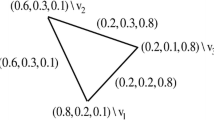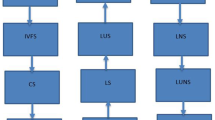Abstract
Recently, three–way fuzzy concept lattice and its application have been introduced to characterize the uncertainty and incompleteness in the attribute set based on acceptation, rejection, and uncertain regions. In this process, a problem is addressed in measuring the bipolar attributes for each component of three–way decision space. To deal with this problem, the current chapter proposes a method for precise representation of bipolar information using the properties of bipolar neutrosophic sets. The proposed method also includes a way to discover some of the useful patterns in the given three–way bipolar neutrosophic context based on user required subset of attributes with its graphical visualization. The hierarchical order visualization of generated bipolar neutrosophic concepts and its interpretation are also discussed with an illustrative example.
Access this chapter
Tax calculation will be finalised at checkout
Purchases are for personal use only
Similar content being viewed by others
References
Akram, M.: Bipolar fuzzy graphs. Inf. Sci. 181(24), 5548–5564 (2011)
Alcalde, C., Burusco, A., Fuentez-Gonzales, R.: The use of two relations in L-fuzzy contexts. Inf. Sci. 301, 1–12 (2015)
Aswani Kumar, Ch., Srinivas, S.: Concept lattice reduction using fuzzy K-means clustering. Expert Syst. Appl. 37 (3), 2696–2704
Bělohlávek, R., Sklenář, V., Zackpal, J.: Crisply generated fuzzy concepts. In: Proceedings of ICFCA 2005, LNAI 3403, pp. 269–284 (2005)
Bloch, I.: Lattices of fuzzy sets and bipolar fuzzy sets, and mathematical morphology. Inf. Sci. 181(10), 2002–2015 (2011)
Burusco, A., Fuentes-Gonzalez, R.: The study of the L-fuzzy concept lattice. Matheware Soft Comput. 1(3), 209–218 (1994)
Broumi, S., Talea, M., Bakali, A., Smarandache, F.: On bipolar single valued neutrosophic graphs. J. New Theory 11, 84–102 (2016)
Broumi, S., Smarandache, F., Talea, M., Bakali, A.: An introduction to bipolar single valued neutrosophic graph theory. Appl. Mech. Mater. 841, 184–191 (2016)
Deli, I., Ali, M., Smarandache, F.: Bipolar neutrosophic sets and their application based on multi-criteria decision making problems. In: Proceedings of 2015 IEEE International Conference on Advanced Mechatronic Systems (ICAMechS), pp. 249–254 (2015)
Djouadi, Y., Prade, H.: Possibility-theoretic extension of derivation operators in formal concept analysis over fuzzy lattices. Fuzzy Optim. Decis. Making 10, 287–309 (2011)
Ganter, B., Wille, R.: Formal Concept Analysis: Mathematical Foundation. Springer, Berlin (1999)
Hu, B.Q.: Three-way decision spaces based on partially ordered sets and three-way decisions based on hesitant fuzzy sets. Knowl.-Based Syst. 91, 16–31 (2016)
Kroonberg, K.M.: Applied Multiway Data Analysis. Wiley, New York (2007)
Lee, K.M.: Bipolar-valued fuzzy sets and their operations. In: Proceedings of the International Conference on Intelligent Technologies, Bangkok, Thailand, pp. 307–312 (2000)
Li, J.H., Huang, C., Qi, J., Qian, Y., Liu, W.: Three-way cognitive concept learning via multi-granularity. Inf. Sci. 378(1), 244–263 (2017)
Mao, H., Lin, G.M.: Interval neutrosophic fuzzy concept lattice representation and interval-similarity measure. J. Intell. Fuzzy Syst. https://doi.org/10.3233/JIFS-162272 (2017)
Pollandt, S.: Fuzzy Begriffe. Springer, Berlin (1998)
Singh, P.K., Aswani Kumar, Ch.: A note on bipolar fuzzy graph representation of concept lattice. Int. J. Comput. Sci. Math. 5(4), 381–393 (2014)
Singh, P.K., Aswani Kumar, Ch.: Bipolar fuzzy graph representation of concept lattice. Inf. Sci. 288, 437–448 (2014)
Singh, P.K., Gani, A.: Fuzzy concept lattice reduction using Shannon entropy and Huffman coding. J. Appl. Non-Classical Logics 25(2), 101–119 (2015). https://doi.org/10.1080/11663081.2015.1039857
Singh, P.K., Aswani Kumar, Ch., Gani, A.: A comprehensive survey on formal concept analysis, its research trends and applications. Int. J. Appl. Math. Comput. Sci. 26(2), 495–516 (2016)
Singh, P.K.: Complex vague set based concept lattice. Chaos, Solitons Fractals 96, 145–153 (2017)
Singh, P.K.: Three-way fuzzy concept lattice representation using neutrosophic set. Int. J. Mach. Learn. Cybern. 8(1), 69–79 (2017). https://doi.org/10.1007/s13042-016-0585-0
Singh, P.K.: Medical diagnoses using three-way fuzzy concept lattice and their Euclidean distance. Comput. Appl. Math. 37(3), 3282–3306 (2018). https://doi.org/10.1007/s40314-017-0513-2
Singh, P.K.: Interval-valued neutrosophic graph representation of concept lattice and its (\(\alpha , \beta , \gamma \))-decomposition. Arab. J. Sci. Eng. 43(2), 723–740 (2018). https://doi.org/10.1007/s13369-017-2718-5
Singh, P.K.: m-polar fuzzy graph representation of concept lattice. Eng. Appl. Artif. Intell. 67, 52–62 (2018b)
Singh, P.K.: Similar vague concepts selection using their Euclidean distance at different granulation. Cogn. Comput. 10(2), 228–241 (2018)
Singh, P.K.: Bipolar fuzzy concept learning using next neighbor and Euclidean distance. Soft Comput. (2018). https://doi.org/10.1007/s00500-018-3114-0
Rivieccio, U.: Neutrosophic logics: prospects and problems. Fuzzy Sets Syst. 159, 1860–1868 (2016)
Sahin, M., Deli, I., Ulucay, V.: Jaccard vector similarity measure of bipolar neutrosophic set based on multi-criteria decision making. In: International Conference on Natural Science and Engineering (ICNASE’16), March 19–20, Kilis (2016)
Smarandache, F.: A Unifying Field in Logics Neutrosophy: Neutrosophic Probability, Set and Logic. American Research Press, Rehoboth (1999)
Ulucay, V., Deli, I., Sahin, M.: Similarity measures of bipolar neutrosophic sets and their application to multiple criteria decision making. Neural Comput. Appl. (2016). https://doi.org/10.1007/s00521-016-2479-1
Wille, R.: Restructuring lattice theory: an approach based on hierarchies of concepts. In: I. Rival (ed.) Ordered Sets, NATO Advanced Study Institutes Series, vol. 83, pp. 445–470 (1982)
Zhang, W.R., Zhang, L.: YinYang bipolar logic and bipolar fuzzy logic. Inf. Sci. 165(3–4), 265–287 (1994)
Yao, Y.: Three-way decision: an interpretation of rules in rough set theory. In: Wen, P., Li, Y., Polkowski, L., Yao, Y., Tsumoto, S., Wang, G. (eds.) RSKT 2009. LNCS, vol. 5589, pp. 642–649 (2009)
Yao, Y.: An outline of a theory of three-way decisions. In: Yao, J., Yang, Y., Slowinski, R., Greco, S., Li, H., Mitra, S., Polkowski, L. (eds.) RSCTC 2012. LNCS, vol. 7413, pp. 1–17 (2012)
Acknowledgements
Author sincerely thanks the anonymous reviewer’s and editor’s for their valuable time and suggestions to improve the quality of this chapter.
Author information
Authors and Affiliations
Corresponding author
Editor information
Editors and Affiliations
Rights and permissions
Copyright information
© 2019 Springer Nature Switzerland AG
About this chapter
Cite this chapter
Singh, P.K. (2019). Three–Way Bipolar Neutrosophic Concept Lattice. In: Kahraman, C., Otay, İ. (eds) Fuzzy Multi-criteria Decision-Making Using Neutrosophic Sets. Studies in Fuzziness and Soft Computing, vol 369. Springer, Cham. https://doi.org/10.1007/978-3-030-00045-5_16
Download citation
DOI: https://doi.org/10.1007/978-3-030-00045-5_16
Published:
Publisher Name: Springer, Cham
Print ISBN: 978-3-030-00044-8
Online ISBN: 978-3-030-00045-5
eBook Packages: Intelligent Technologies and RoboticsIntelligent Technologies and Robotics (R0)




